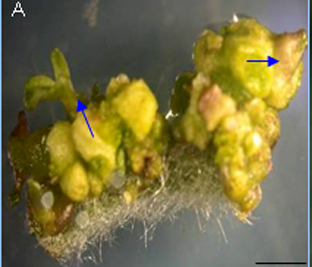以朝鲜白头翁(Pulsatilla koreana)的叶柄为材料诱导分生结节, 利用常规石蜡切片法和树脂包埋切片法研究了朝鲜白头翁离体形态发生的解剖学特点。结果表明: 叶柄在MS+3 mg⋅L–1玉米素(zeatin, ZEA)+0.5 mg⋅L–1吲哚乙酸(IAA)的诱导培养基上培养42天后, 分生结节诱导率为82.5%; 培养56天后, 95%的分生结节转化成不定芽。组织解剖结构观察结果显示, 培养7、14、28和42天时分别观察到前分生结节结构、形成层和拟分生组织结构、顶端分生组织、叶原基结构。朝鲜白头翁的不定芽起源于分生结节内部的维管中心。新分化芽基部类似愈伤组织的细胞团的显微切片结果显示, 基部组织上分布着表皮细胞或下表皮细胞、维管束形成层和拟分生组织细胞, 它们在朝鲜白头翁器官分化中发挥重要作用。
Paraffin sections of Pulsatilla koreana petiole explants were studied to illustrate the microstructure of the meristematic nodule and plant regeneration pathway. Meristematic nodules could be induced from petiole explants on Murashige and Skoog medium containing 3 mg⋅L–1 zeatin with 0.5 mg⋅L–1 indole acetic acid. After 42 days of culture the frequency of nodule induction was 82.5%, and 95% of nodules converted to adventitious shoots after 56 days culture. Globular structures were observed after 14 days’ induction. Prenodular structures of cambial origin appeared from the calluses and gave rise to nodules; shoot buds formed after 28 days’ of culture. Nodules kept giving rise to sub-nodules, from which arose an increasing number of shoot buds. Most apical meristem structures with leaf primordia were observed after 42 days’ culture. Meristemoid regions and cells were much smaller in callus-like tissue than in surrounding cells. Some parts of the sections showed epidermal or sub-epidermal cells, vascular cambium, and meristemoid cells, which were regularly or irregularly distributed on the callus-like tissue. These structures provide evidence that callus-like tissue plays an important role in Pulsatilla species for shoot or root differentiation.

[1]黄泰康,尤啓冬,史美谣 (1994). 常用中药成分与药理手册. 北京:中国药学科技出版社:743
[2]廉玉姬,赵小梅,林光哲.朝鲜白头翁的组织培养与快繁技术[J].园艺学报,2010,37:491-498
[3]赵 渤,鲁新海 (2002). 药用花卉栽培和利用. 北京:中国农业出版社:311
[4]钟原, 成仿云, 秦磊.分生结节: 一种有价值的植株再生途径[J].植物学报,2011,46:350-360
[5]Aitken-Christie J, Singh AP (1988). Multiplication of meristematic t: a new t culture system for radiata pine. In: Hanover JW, Keathley DE (eds) Genetic manipulation of woody plants. Plenum, New York. pp. 413–432
[6]Bae KH (1999). The medicinal plants of Korea. Kyo-Hak Press 139
[7]Bang SC, Kim Y, Lee JH (2005a). Triterpenoid saponins from the roots of Pulsatilla koreana. J Nat Prod 68, 268–272
[8]Bang SC.[J].Lee JH, Song GY, Kim DH, Yoon MY, Ahn BZ (2005b). Antitumor activity of Pulsatilla koreana saponins and their structure activity relationship. Chem Pharm Bull,1451,53:-
[9]Batista D, Ascens?o L, Sousa MJ, Pais MS.Adventitious shoot mass production of hop (Humulus lupulus L[J].) var. eroica in liquid medium from organogenic nodule cultures. Plant Sci,2000,151:47-57
[10]Cho SC, Zakir SM, Moon SS.Anti-acne activities of pulsaquinone, hydropulsaquinone, and structurally related 1, 4-quinone derivatives[J].Arch Pharm Res,2009,32:489-494
[11]Ferreira S, Batista D, Serrazina S, Pais MS.Morphogenesis induction and organogenic nodule differentiation in Populus euphratica Oliv[J].leaf explants. Plant Cell T Organ Cult,2009,96:35-43
[12]George EF, Hall MA, de Klerk GJ (2008). Plant propagation by t culture, 3rd edn, Vol 1, The Background. Dordrecht: Springer. pp. 1–64
[13]Godo T, Kobayashi K, Tagami T, Matsui K, Kida T.In vitro propagation utilizing suspension cultures of meristematic nodular cell clumps and chromosome stability of Lilium ?ormolongi hort[J].Sci Hortic,1998,72:193-202
[14]Jung SJ, Jeong JH, Yoon ES, Choi YE (2007). Plant regeneration from callus and adventitious root segments of Pulsatilla koreana Nakai. J Plant Biotechnol 34:153–159
[15]Ko JA, Kim HS.Effective micropropagation of Pulsatilla cernua var koreana through apical meristem culture[J].Korean J Plant Res,2008,21:362-367
[16]Ko JA, Kim HS.Microspore-derived embryogenesis and plant regeneration from anther culture of Pulsatilla cernua var[J].koreana. Korean J Hort Sci Technol,2006,24:290-295
[17]Kongbangkerd A, K?pf A, Allacher P, Wawrosch C, Kopp B.Micropropagation of squill (Charybdis numidica) through nodule culture[J].Plant Cell Rep,2005,23:673-677
[18]Lee HS, Beon MS, Kim MK.Selective growth inhibitor toward human intestinal bacteria derived from Pulsatilla cernua root[J].J Agric Food Chem,2001,49:4656-4661
[19]Lee MS, Oh KH.Histological studies on in vitro propagation of Pulsatilla koreana Nakai[J].Korean J Med Crop Sci,1993,1:137-157
[20]Lin GZ, Zhao XM, Hong SK, Lian YJ.Somatic embryogenesis and shoot organogenesis in the medicinal plant Pulsatilla koreana Nakai[J].Plant Cell T Organ Cult,2011,106:93-103
[21]McCown BH, Zeldin EL, Pinkalla HA, Dedolph RR (1988). Nodule culture: a developmental pathway with high potential for regeneration, automated micropropagation and plant metabolite production from woody plants. In: Hanover JW, Keathley DE, eds. Genetic manipulation of woody plants. New York & London: Plenum Press. pp. 149–166
[22]Mimaki Y, Kuroda M, Asano T.Triterpene saponins and lignans from the roots of Pulsatilla chinensis and their cytotoxic activity against HL-60 cells[J].J Nat Prod,1999,62:1279-1283
[23]Murashige T, Skoog F.A revised medium for rapid growth and bioassays with tobacco t culture[J].Physiol Plant,1962,15:473-497
[24]Piéron S, Dekegel D, Boxus P.Histological study of nodule morphogenesis from Cichorium intybus L[J].leaves cultivated in vitro. In Vitro Cell Dev Biol —Plant,1998,34:87-93
[25]Quoirin M, Vieira RC.Rhizogenesis and nodule formation from callus of Eucalyptus grandis and E[J].grandis xurophylla. Arq. Biol. Tecnol,1995,38:793-798
[26]Salaj J, Petrovská B, Obert B, Pret’ová A.Histological study of embryo-like structures initiated from hypocotyl segments of flax (Linum usitatissimum L[J].). Plant Cell Rep,2005,24:590-595
[27]Sang CK, Kim EH, Kim HY.Germination and life span of Pulsatilla cenua var[J].koreana seeds. J Kor Soc Hort Sci,1993,34:207-212
[28]Te-chato S, Lim M.Improvement of mangosteen micropropagation through meristematic nodular callus formation from in vitro-derived leaf explants[J].Sci Hortic,2000,86:291-298
[29]Teng WL.An alternative propagation method of Ananas through nodule culture[J].Plant Cell Rep,1997,16:454-457
[30]Warrag E, Lesney MS, Rockwood DJ.Nodule culture and regeneration of Eucalyptus grandis hybrids[J].Plant Cell Rep,1991,9:586-589



